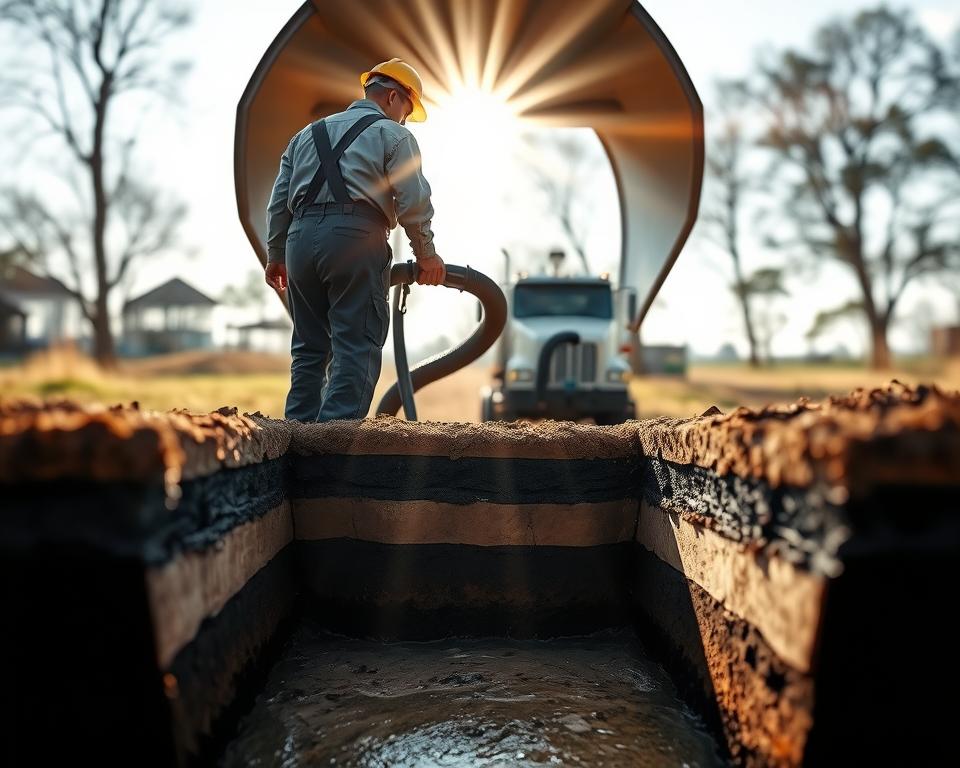Aerobic Tank Air Pump: Complete Guide for Property Owners
Have you ever wondered what powers your oxygen-based Septic system’s effectiveness? The Septic air pump is the unsung key component indispensable for your system. In this article, readers will acquire essential know-how on the air Pump’s role. It’s critical for a sound, well-run Septic system.
Grasping the value of a Septic tank air Pump can optimize your Septic system’s operation using septic tank cleaning companies. It also safeguards your asset value and ecological well-being. Our handbook will introduce All in Sanitation, a well-regarded Septic industry expert. They’re equipped to meet your Septic aerator Pump needs.
Core Lessons
- The Septic air Pump is vital for aerobic Septic systems.
- Looking after your Septic system air Pump can boost overall system performance.
- Scheduled assessments increase the service life of your Septic tank air Pump.
- Picking the best-fit Septic aerator Pump is necessary for top operation.
- All in Sanitation offers expert services for Septic air Pump support.
Understanding Aerobic Septic Solutions
Aerobic Septic systems offer a superior waste treatment approach by using oxygen. This process consists of aerobic bacteria thriving in well-oxygenated environments. These bacteria are more efficient in processing organic matter. With the help of Septic aerator Pumps, these systems deliver a constant oxygen supply, improving the waste decomposition process.
These systems excel in minimizing sludge buildup, thanks to the activity of aerobic bacteria. This reduction in solid waste means minimal cleaning and tank Pump-outs is necessary. Additionally, they effectively manage wastewater, creating reduced odors. This ensures a better environment for homeowners and the community alike.
To confirm these systems run successfully, it’s crucial to grasp the key Septic system components. These include the Septic tank, oxygenation chamber, and effluent Pump. Each part serves a key function, especially the air Pump. It pushes oxygen into the tank, central for the aerobic bacteria’s activity.
Importance of the Septic Air Pump
The Septic air Pump is pivotal in the running of aerobic Septic systems. It acts as the system’s “lungs,” pushing the needed oxygen needed. This oxygen permits aerobic bacteria to thrive and digest waste quickly. If the Pump breaks, the system’s capability decreases, causing sludge increase and possible odors.
Such issues can disrupt Septic system operations and lead to environmental hazards. By recognizing how critical the Septic air Pump is, homeowners can respond ahead of time. They can ensure its best function through regular maintenance. This avoids failures, reduces costly repairs, and maintains the aerobic system’s integrity.
Top Advantages of Using a Septic Air Pump
Utilizing a Septic air Pump markedly increases the performance of Septic systems. Septic air Pumps are crucial as they fast-track the processing of waste. This is achieved by oxygenating the treatment process, supporting aerobic bacteria growth. These bacteria are necessary for efficient waste treatment.
They’re also helpful in cutting foul smells. Because of more active aerobic processes, waste is processed faster, thus cutting down odors. This provides a fresher environment for homeowners.
Another valuable benefit is the decrease in sludge formation. Consequently, tanks need less frequent Pumping, cutting both money and time. Improved processing not only reduces spending but also prolongs the lifespan of the drain field.
Looking after these Pumps properly means minimal repair costs and satisfying regulatory standards. Thus, the benefits of Septic air Pumps are not only for homeowners. They also support environmental health by advancing waste management practices.
| Benefit | Description |
|---|---|
| Fast Waste Breakdown | Greater aerobic activity quickens the decomposition process. |
| Minimized Odor Emissions | Optimized treatment efficacy leads to fewer odors. |
| Reduced Sludge Buildup | Minimal Pumping and maintenance are required. |
| Extended Drain Field Life | Better treatment equals a healthier drain field. |
| Cost Savings | Lower chance of repairs and regulatory compliance cost. |

Selecting the Best Septic Air Pump
Picking the best Septic air Pump is critical for an effective aerobic system. Homeowners should assess various factors for the proper choice. The size of the tank and the airflow specifications are important the Pump’s output.
To choose intelligently, it’s helpful to understand the air Pumps available. There are mainly two types: diaphragm Pumps and rotary vane Pumps. Each provides distinct advantages, which should be paired with your home’s specific needs and operational profile.
Power consumption also should be considered. Picking a Pump that minimizes energy use while providing the needed airflow can result in noticeable cost cuts. Help from All in Sanitation professionals can be priceless. They make certain the Pump you choose suits your system’s requirements exactly.
Major Kinds of Septic Air Pumps
Homeowners can make better choices by being aware of the multiple Septic air Pumps available. There are mainly two types: diaphragm Pumps and rotary vane Pumps. Each has its unique functions and benefits.
Diaphragm Pumps, known for their quiet operation, are popular for residential Septic systems. They provide energy efficiency while supplying consistent airflow. Their trustworthy performance fits smaller systems, meeting the needs of many homeowners.
Rotary vane Pumps, however, are better suited for higher-capacity or commercial systems. These Pumps produce higher capacity, essential in handling bigger loads. Their strong build guarantees efficient operation in extensive Septic systems.
| Type of Pump | Best Use | Advantages |
|---|---|---|
| Diaphragm Pumps | Residential Systems | Quiet operation, energy-efficient, reliable air flow |
| Rotary Vane Pumps | Larger or Commercial Systems | Powerful performance, high capacity, durable construction |
Appreciating the differences in Septic air Pumps is vital for upgrades or replacements. Each Pump type offers specific features to meet various needs. This secures optimal performance for any system.
Signs You Might Need a Septic Air Pump Replacement
Homeowners must monitor Pump failure signs in their Septic systems. Some indicators suggest the need for a Septic air Pump replacement. These help maintain smooth operation. Catching these promptly prevents serious issues.
Signs of potential problems include:
- Unusual noises from the Pump, like rattling or shaking, might show internal damage.
- A clear lack of air output means the Pump isn’t operating efficiently, harming efficiency.
- Repeated electrical problems, such as circuit trips or voltage drops, could indicate overloading.
- Visible damage on the Pump unit, with cracks or leaks, requires quick action.
- Offensive smells in the yard often indicate a compromised Pump, meaning ineffective effluent aeration.
Recognizing these signs early stops high repair bills or total system failure. Scheduling regular checks helps spot these issues. It also clarifies if you should get a new Septic air Pump.
Service Tips for Your Septic Air Pump
For an effective Septic air Pump, consistent service is vital. This ensures that that your system functions properly. Homeowners can employ several simple care strategies for peak results.
Twice a year, perform a comprehensive inspection for wear or damage. It is also necessary to replace the filters as suggested. This prevents clogs that could lower efficiency.
The Pump should be placed on a firm base to reduce vibrations, which could damage it over time. A protective cover is important too. It guards against debris and water, sustaining the Pump’s functionality.
Regular servicing can significantly prolong the life of your Pump. In turn, this helps the Septic system’s performance overall.
| Maintenance Task | Frequency | Benefits |
|---|---|---|
| Inspect Pump for damage | Every 6 months | Identifies issues early |
| Replace filters | As needed | Improves efficiency |
| Check surface stability | Annually | Reduces vibrations |
| Clear debris around Pump | Monthly | Prevents clogs |
Placing Your Septic Air Pump
Accurate installation of your Septic air Pump is vital for its efficient operation. To start, pick a secure, moisture-free area for placement. The chosen spot should firmly hold the Pump’s weight with ease.
To reliably install your Pump on your own, follow the following guidelines:
- Gather all necessary items, including the Pump, a power source, and hose fittings.
- Thoroughly review the manufacturer’s guidelines before beginning your installation.
- Make sure every connection is proper to avoid air leaks that hurt performance.
- After assembly, complete a test to check the system works as intended.
If the installation process feels tricky, call All in Sanitation. Their professionals can avoid common errors, confirming your setup meets mandatory safety requirements.
Reasons to Select All in Sanitation for Your Septic Air Pump Solutions
When picking a Septic service provider, the choice is crucial. All in Sanitation separates itself by providing dependable Septic air Pumps. They cater to diverse homeowner requirements with a broad selection of high-grade products. This makes sure customers discover an perfect match for their Septic systems.
What really sets apart All in Sanitation is in addition to their diverse product lineup. Their devotion to exceptional customer service is equally significant. Homeowners get specialist insight, guiding them towards trusted Septic solutions. This joint effort is essential to adapt each solution to satisfy specific needs.
All in Sanitation also puts first aftercare to ensure lasting satisfaction. Their dedication continues beyond the initial sale. They provide ongoing support to preserve Septic systems working well for the long term.
Financial Aspects for Septic Air Pumps
Understanding the financial elements connected with Septic air Pumps is important for homeowners who run aerobic Septic systems. To start, one faces the purchase price, which includes the Pump and associated accessories. Installation expenses change, based on the system’s complexity and any modifications required.
Ongoing upkeep forms an additional cost layer. Routine checks can ward off bigger issues, eventually resulting in savings. Homeowners should allocate money for Septic maintenance to maintain the Pump’s effectiveness and life expectancy. Such planning sidesteps expensive repairs later on, illustrating the advantage of proactive maintenance.
| Cost Component | Average Cost Range |
|---|---|
| Septic Air Pump | $500 – $1,200 |
| Installation | $300 – $800 |
| Annual Maintenance | $150 – $400 |
| Potential Repair Costs | $1,000 – $5,000 |
Dividing Septic air Pump expenses into separate parts aids homeowners in cost forecasting. This thorough approach secures the system’s smooth operation and their reassurance.
Bringing It All Together
For homeowners with aerobic Septic systems, looking after Septic systems is essential. The appropriate Septic air Pump boosts waste processing and extends your system’s life. Committing to regular upkeep and immediately resolving issues stops large repair bills and disruptions.
Choosing a Septic air Pump calls for deliberation. This guide highlighted how to make smart choices about installation and replacement. With All in Sanitation’s help, you can handle your Septic systems’ complexities securely.
Taking care of your Septic air Pump supports your system’s performance and life span. It provides a trouble-free and optimal operation over time. Keep in mind, your home’s wastewater management is strongly influenced by proper care.

